OKX Ventures: Looking at the history, technology and future of TON ecology from an investment perspective
Original author: OKX ventures researcher Twitter @KiwiCryptoBig.
This article only analyzes limited information on the current market and does not constitute any investment advice.
KeyTakeaways
1.Ton’s history and development
The development history of TON has been tortuous. It was founded in 2018. The ICO in 2019 was rejected by the SEC in 2020. After being launched in the form of new TON, the TON Foundation restarted ecological construction in 2022; Telegram bot has many ecological hot spots, and Telegram Wallet and TON Space are expected to The full volume launch in November has brought TON’s recent market value growth ($3B-$7B, +292%) and high valuation level (mcap/TVL = 654); the current chip structure is concentrated, and the foundation is vigorously promoting OTC transactions; currently Has been transferred to POS, with an annual inflation rate of 0.6%, and the current staking can obtain approximately 3.73% APY;
Telegram user situation: 800 million MAU; TON active users 3.5 M, expected to cover 30% Telegram users, Target 2028 500 M users; users cover non-Chinese and American users (India 100 million DAU 300 million MAU, Russia, Indonesia and Malay market share rate exceeds 60%); Telegram user tags, focusing on news, entertainment and education, coupled with the Twitter ecosystem (59.5% of users also use Twitter), high stickiness (average daily usage time 4 hours);
TON infrastructure opportunities: The underlying development language is FUNC (difficult, similar to c++). Recently, the official has provided a compiler TACT that can use scripting languages, but the efficiency is compromised; the early TON ecosystem developers came from former employees of VKontakte created by Durov. Currently, The core devs of the application layer come from South Korea and Russia;
2.Ton’s framework and technology
TON architecture: uses an adaptive infinite sharding multi-chain architecture, including masterchain (coordination core chain), workchain (work chain, a collection of shard chains), shardchain (shard chain, which further divides the work chain and improves processing) efficiency). Each account acts as a shardchain and can be adaptively combined into a larger shardchain to suit transaction needs. TON builds an efficient and secure blockchain network through adaptive unlimited sharding, asynchronous information transfer and a special consensus mechanism.
TON implements asynchronous information transfer and hypercube routing mechanisms. Each transaction in the system is executed only on a single smart contract, communicated through asynchronous messages. Messages are routed from one shard chain to the target shard chain through the hypercube, and also provide fast routing, that is, message preprocessing and routing.
TON consensus mechanism: It adopts a hybrid method of PoS and BFT, and the network contains roles such as verification nodes, Fisherman, and proofreaders. Validation nodes are pledged and elected once a month. Fisherman and proofreaders are respectively responsible for detecting verification nodes and recommending new verification nodes.
Problems such as MEV and flash loan attacks have not yet appeared. Each node transmits information through adjacent nodes, using different information paths, and there is no mempool structure. Through the fast routing mechanism, transactions that have been passed by adjacent shard chains will be deleted from the output queue to prevent double spending.
TON advantages and problems: Solana and Ethereum have the advantages of fast block confirmation time, short transaction time, large maximum number of shards, and fast shard communication speed. Each smart contract needs to pay its own resource costs, including computing, storage, and network transmission. What’s great is that when the TON balance is exhausted, the smart contract will be automatically deleted, thereby avoiding blockchain data expansion. TONs asynchronous design also makes the extensive consistency and atomicity of calls between smart contracts more difficult to maintain, making application development and maintenance work more complex.
3.TON native components
TON P2P network: DHT positioning + ADNL communication network transmission protocol;
TON DNS: Distributed domain name system, available to users and developers, with high unit price;
TON storage: A dropbox-like storage solution using BT technology, decentralized Amazon S 3. Developers can deploy contracts on storage, and the user side is complicated to use;
TON Proxy: A network anonymity layer that hides the IP address of TON nodes and is basically available;
TON payments: There are two directions. @Wallet is for web2 users and can only receive payments. Currently, the web3-oriented TON space is launched to aggregate payments, social networking and other ecosystems;
Telegram Apps Center: for dapp developers to seamlessly develop and integrate on the chain;
4.Telegram ecology and Ton ecology
The current Telegram ecological form is Bots+API+Wallet Hosting, which has good data but no actual support for the TON public chain;
Why do project parties want to go to the TON ecosystem? Apps Center backflow in Telegram, TON native payment, telegram community promotion, foundation grants and investments, lifting API restrictions, etc. can all help project development; the corresponding experiences are: Instant launch, User friendly interface, Push notifications, Social and game mechanics , Seamless Web3 integration.
Why does Telegram support TON? Telegram has monetization needs, its listing expectations are unknown, and its revenue structure is single, and TON may be one of the best ways to commercialize it;
Currently, TON ecological applications are mainly in the form of Bots + API + wallet hosting + TON token mapping. There are few applications developed entirely using FUNC, and the infrastructure is relatively difficult to use. Therefore, developer tool middleware such as TONfura has emerged;
It has officially included 551 applications, including staking, wallets, public facilities, NFT, social networking, games, decentralized exchanges, etc., with a large number of DEX, lending, and games, and a rich ecosystem;
5. Investment reference ideas
Be optimistic about the officially supported infrastructure: TON components are available but the experience needs to be improved. We need to combine and optimize the experience around the infrastructure, such as one-stop deployment of infra, dynamic site search engine, dashboard and aggregator, etc.;
Be optimistic about mini program applications: value the diversity and breadth of mini programs, prefer web 2.5 for mass adoption, and have product experience and security greater than crypto legitimacy. Ton space and telegtam entrances can attract a large amount of web2 traffic. On the application side, there are traffic sources, application scenarios, social relationships, payment gateways and user reach needs. In these five directions, you can invest in some projects with strong technical/ecological backgrounds;
Be cautiously optimistic about DeFi, MEV and ZK: The DeFi products currently needed most by the ecosystem tend to be stable revenue pools and trading infrastructure, rather than complex DeFi product innovation; in the traditional crypto direction, it is too early to consider MEV, ZK and bridge, and the current primary purpose is It is to create more assets and build a stable product chain; it is not optimistic about the direction of Layer 2 and zk in the short term;
Other track directions: Dev Tools has high technical requirements for the team and needs to maintain close communication with the official + official component coupling, which is difficult; the binding direction of Social Payment and games + social graph can consider small games combined with the token economy , or a social platform that solves the interaction between creators and users.
1.Ton’s history and development
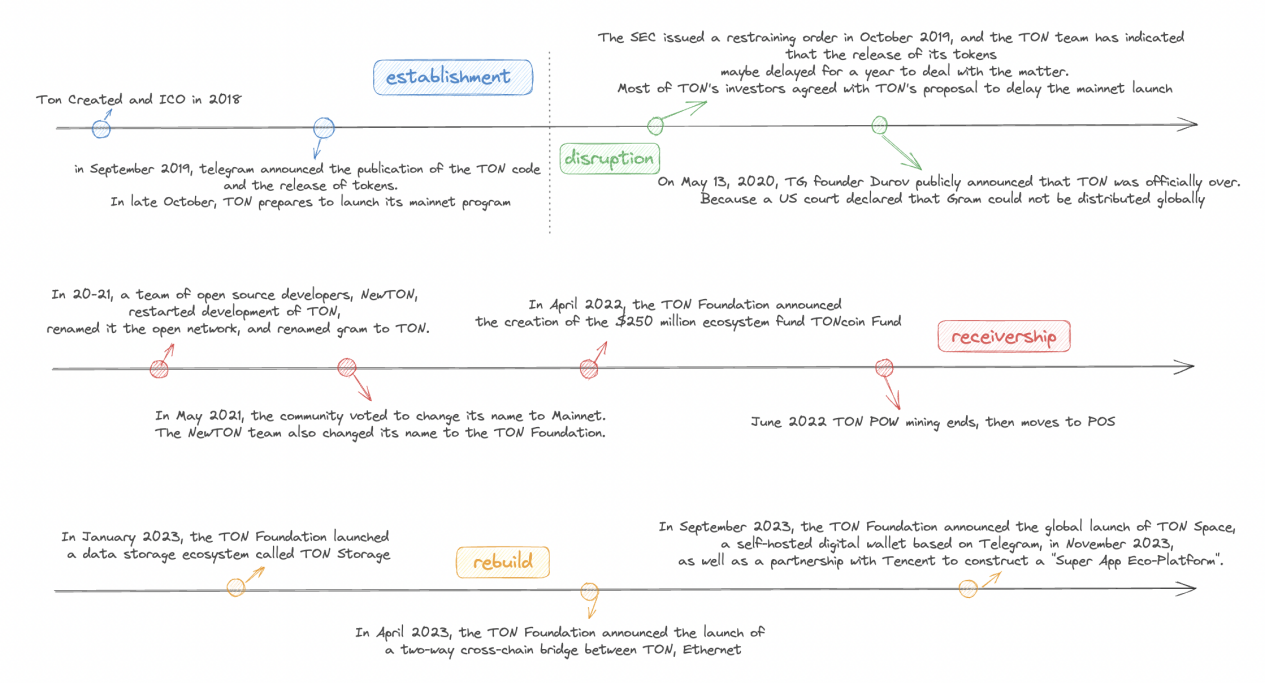
Team Profile
TON and telegram are essentially two separate legal entities, but have signed a commercial agreement. The development of TON is mainly driven by the TON Foundation.
More than half of the TON Foundation team comes from Russia, Ukraine and other countries, and some of the founders and employees have working experience in VK and Telegram.
Token situation
(Data as of early October 2023)
Token utility: smart contract transaction processing fees, payment platform application services, pledge, cross-chain transactions, TON governance and storage services, and can be used to pay for TON agency services in the future;
Token price: The current token price is $2.04, which has increased by 292% from the lowest price in September 21 ($0.51). The currency price has fluctuated between $1.5-$2.5 in the past year. From the end of 2022 to the middle of 2023, the construction of TON ecology led to a steady increase in token prices. From May to August 2023, Telegram bot exploded. The fanatical attention to the bot ecology affected the ecological narrative of TON itself. The token price has The popularity of Telegram bot has declined since August 23, and the token price has rebounded amid fluctuations.
Market Performance FDV and TVL
(Data as of early October 2023)
Market value performance: The current market value is $7 B. The market value was stable at around $3 B from November 22 to July 23. The market value has increased to around $7 B since mid-July 23. From July to August 23, TON integrated a built-in wallet, cooperated with bit.com, and launched the TAPP application center at the same time, achieving an ecological milestone. Telegram Wallet and TON Space are expected to be fully operational in November 2023.
TVL $ 10.86 m; FDV $ 10 B. mcap / TVL = 654. Compared with Ethereum (9.33), Solana (29.6), and polygon (6.5) as benchmarks, TON’s valuation is slightly higher.
Tokenomics
Token supply: The initial supply of TON token is 5 billion, with no upper limit, growing at an annual rate of about 0.6% (about 30 million). The token is used to reward verifiers. If the verifier behaves inappropriately, the pledged The token will be slashed, and currently you can get about 3.73% APY by staking TON;
Token Utility: Telegram wallet can currently purchase TON directly with a credit card, and then purchase virtual goods such as anonymous accounts. Telegram promotion may also consume TON in the future;
Token distribution: The team owns 1.45% of the tokens, and the remaining 98.55% were mined by POW in the early stage. That is to say, a large amount of chips are concentrated in the hands of early miners. The team has introduced the following measures to optimize this problem: First, in February 23, the TON Token Economic Model Optimization Proposal was passed, and inactive wallets were frozen for 48 months (a total of 171 wallets, holding There were more than 1.081 billion TON, accounting for 21% of the total at that time); followed by reselling TON in large quantities at discounted prices;
Chip distribution: Currently 85.53% of users hold TON worth less than $1k, 14.05% of users hold TON worth $1k - $100k, and only 0.42% of whales hold TON worth more than $10w; The number of holders who have held the token for more than one year is about 18.08% of the total holders, and the proportion of holders who have held the token for about one month is 12.20%.
income
Transaction fees: The current average Gas fee for each transaction of TON is around 0.1-0.5 US dollars, which is much lower than Tron’s 1-2 US dollars and Ethereum’s 7 US dollars;
Payment fees: Developers will pay fees for smart contracts, and users can also use TON to pay for premium subscriptions to certain services;
Telegram / TON domain name service: Currently, 34,000 DNS have been sold (the number of ENS domain names that have been forged on Ethereum is 2.574 million), with sales of 6.26 million TON, which is expected to be US$12 million at the current price, with an average price of US$375/DNS , the price is relatively high;
Whale Club NFT: Users can get exclusive activities such as private staking pool, whale accelerator program, member discounts and more.
2. User and developer information
User Info
Telegram users are growing rapidly: Telegram has been the fastest growing APP in 22 years and is currently the fourth largest instant messaging software in the world. Telegram currently has more than 800 million monthly active users, which is 1.4 times that of Twitter (556 million), 0.61 times that of WeChat (1.309 billion), 0.86 times that of Facebook Messenger (931 million), and more than Douyin (715 million). At the same time, more than 2.5 million new users register for Telegram every day (data as of January 2023);
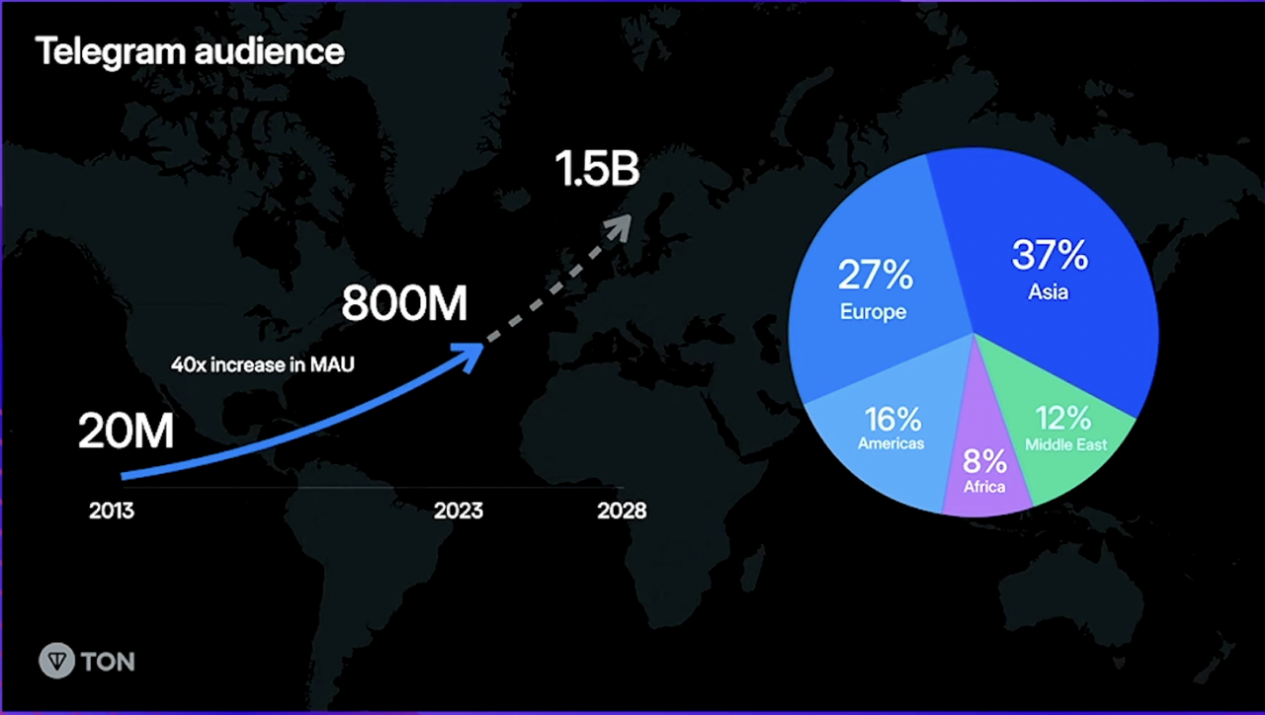
https://youtu.be/VC5G2581M8s?si=f4nDiZXvefp-hE1r
Telegram has a rich ecosystem and expands blockchain scenarios: Telegram is also an e-commerce platform, and Chinese foreign trade companies are one of the biggest beneficiaries (export goods sold through the Telegram platform reached $1.2 m in 2020);
Telegram has a large user base, especially users from countries other than China and the United States:
1. Telegram is popular in Russia, India and Brazil: In 2022, Telegram was downloaded 34.91 million times in Russia, surpassing second-place AliExpress (29.29 million times). This can also be seen from the fact that many APPs in the TON ecosystem only support English and Russian. In addition, the country with the largest number of Telegram users is India, with 86.6 million people. Ranking second is Brazil (15.8 million people), followed by the United States (10.89 million people);
2. The countries with the highest market share of Telegram are Russia, Indonesia, and Malaysia: According to data from Q3 2022, the market share of Telegram (the number of Internet users using Telegram) in Russia, Indonesia, and Malaysia all exceeds 60%. Followed by Brazil, Saudi Arabia, India, Nigeria, Egypt, Turkey and Cambodia, these countries also have a market share of more than 50%;
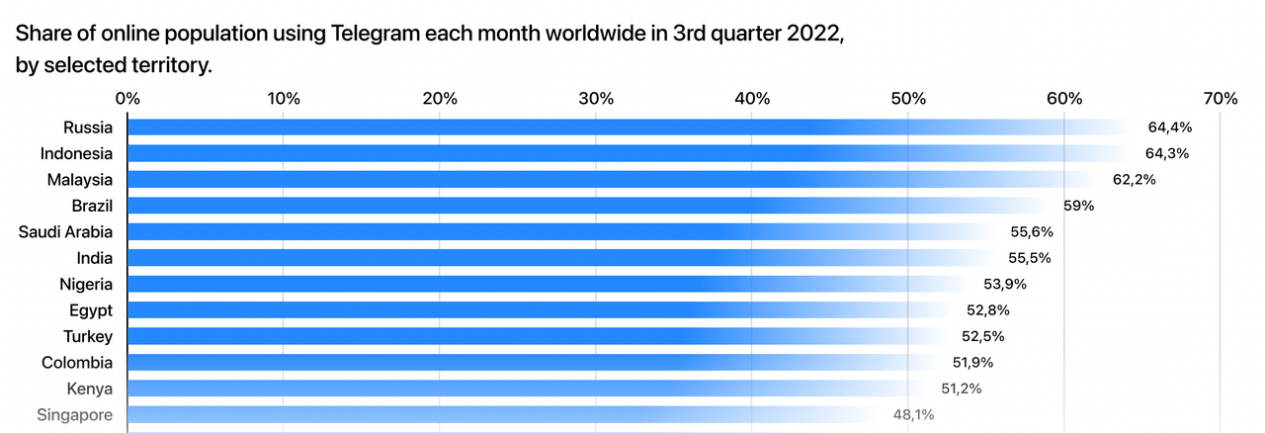
The content that Telegram users pay attention to is mainly news, entertainment and education content, and it is deeply tied to the Twitter ecosystem: the most popular content in Telegram is still news content, which accounts for 85%, and 59.5% of users use Telegram. of users also use Twitter;
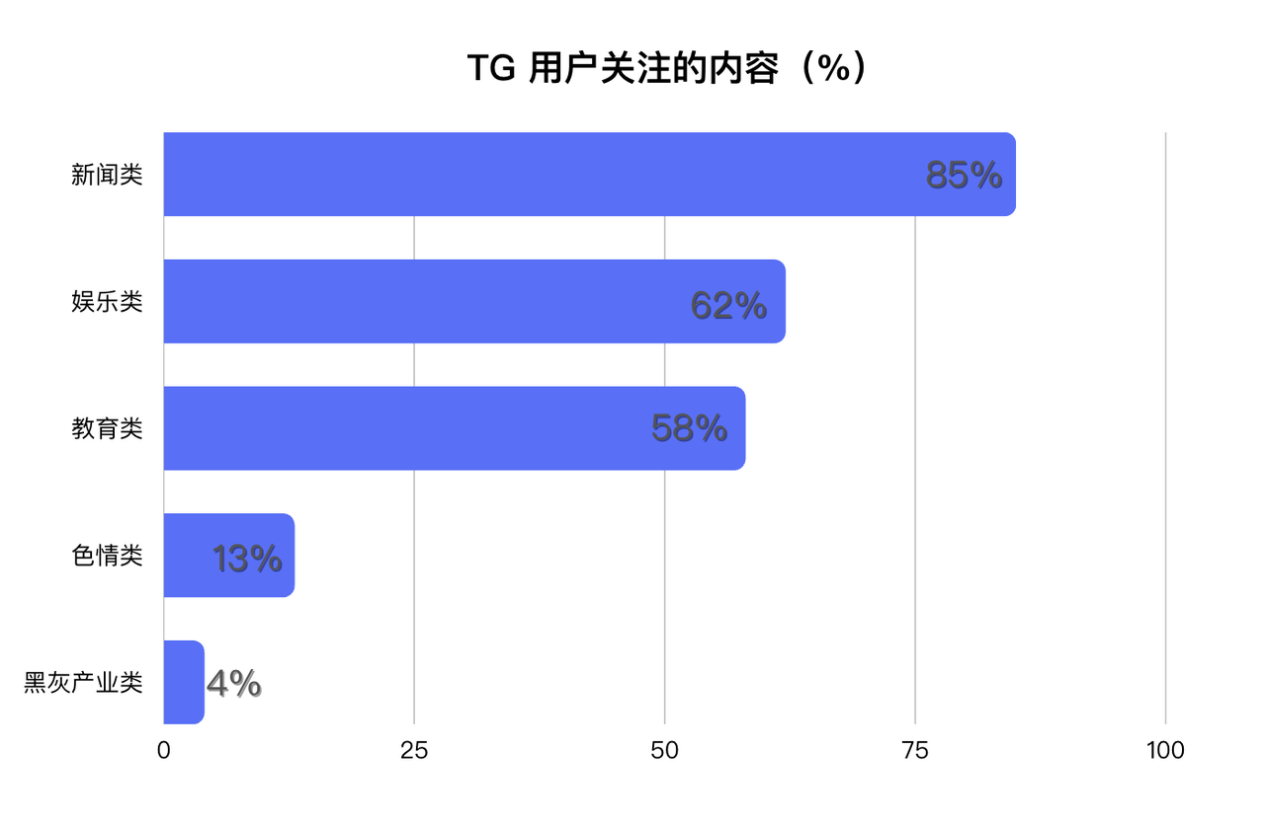
Telegram’s user stickiness is high: According tostatistas data, global Internet users will spend 151 minutes on social networks every day in 2023, and in 2022, the average user will spend 4 hours per month on Telegram, and user stickiness exceeds the global average;
The advertising recommendation mechanism for Telegram users is inefficient: Due to the anonymous nature of Telegram and the fact that Telegram does not have an accurate advertising recommendation system, the traffic support promised by the TON ecosystem is currently extremely inefficient;
TON expected coverage increase: according toofficial data
1. TON’s account growth is stable: There are more than 3.5 million accounts on the TON chain, an increase of 176% in the past 6 months. There are 810,000 daily active users on the chain, an increase of 154% in half a year. And since January 2022, the number of new users every day has fluctuated around 1.5k, and the growth has been relatively stable. TON is expected to cover 30% of Telegram users and Target 500M users in 2028;
2. The number of validators is 349, distributed in 25 countries, and the number of pledges is close to 500 million TON, accounting for 10% of the total tokens and 14% of the circulating tokens;
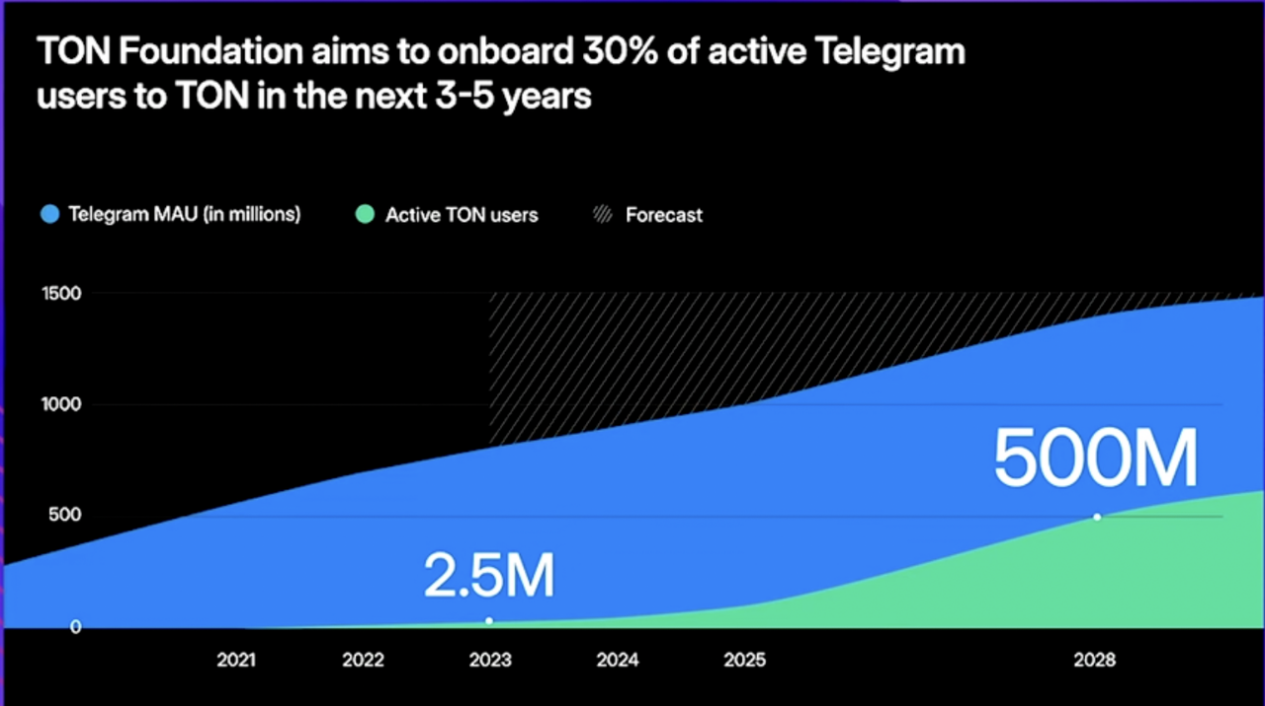
https://youtu.be/VC5G2581M8s?si=f4nDiZXvefp-hE1r
Developer situation
Development language
Low-level language: There are two types, one is FUNC, which is similar to C++ and is very difficult; the other is low-level Fift, which includes TVM and Fift assembly instructions and is more difficult;
Optimized compiled language: An advanced compiled language is currently launchedTACT, the development difficulty can be reduced by 40%. Those with type script development experience will get started quickly. The benchmark developer situation is that senior developers from major manufacturers can get started quickly. Its characteristics are as follows:
1. Friendly syntax: Tact syntax is inspired by JavaScript, Rust and Swift, and is friendly in terms of algebraic data types and compile-time execution;
2. Actor-oriented: Tact is a strongly typed message designed specifically for the TON actor model to enforce a communication contract between participants, providing algebraic data types compatible with the TL-B scheme;
3. Gas control: Tact verifies through Gas commit and the compiler. The Gas cost is either statically limited or explicitly checked at runtime.
Developers should pay attention to the following points when developing (fromBeosin Security Team):
1. Both FunC and Tact are statically typed languages, and developers need to know very clearly the data types stored in variables in their codes;
2. The TON blockchain does not contain revert messages, and developers need to consider the end path of code execution;
3. The TON blockchain has multiple transaction phases (computational phase, actions phase and bounce phase). Developers need to pay attention to which phase the transaction execution is currently in when testing the code;
4. The TON blockchain is asynchronous, and developers need to pay attention to handling failed call information;
5. For external messages, developers need to pay attention to the risk of replay attacks. Replay attacks can be avoided by setting counters or identifiers.
development data
Developers: Many developers come from telegram, and most of the core devs come from South Korea and Russia. They are characterized by strong technical capabilities but average product experience. according todevelop report data, as of October 2023, there are 28 full-time developers (daily code increase and decrease of 10+), 77 part-time developers, and 124 monthly active developers on Ton. The number of active developers surged from early 2022 to May 2023 and has declined recently. The overall number of developers is smaller than other ecosystems.
For comparison, the number of full-time developers in Ethereum is 1,900, and the number of full-time developers in public chains such as Polkadot, Cosmos, and Solana is 300-500, and the top ten public chains are all above 130.
Documentation and related channels:
1. Documentation: Currently, the official website developer documentation is relatively simple, with only three main parts: smart contracts, DAPP development, and integration with TON. The official website hasQA Section, developers can communicate on technical issues (currently 496 in total, an average of 40-50 per month), but fewer questions receive replies. according todevelop report data, there are 1750+ TON related code libraries in the entire network;
2. Channels: They are all Telegram channels, which are very popular and active. Each channel has an average of 50-100 messages per day.
Telegram English developerchannelThere are currently 5,667 users, with an average of about 100 messages per day. Most of the questions are about code and deployment;
Telegram Chinese developerchannelThere are 1596 people, with an average of 50 messages per day;
TACTs official Telegram group has 1,287 developers, with an average of 50-100 messages per day, and is highly active;
Jetto wallet address: Although the total account address exceeds 3.5 million, there are only 143,000 Jetto wallet addresses, and only a few users are deeply involved in the Ton ecosystem;
Jetton is the fungible token standard of the TON blockchain. The Jetton wallet contract is used to send, receive and burn tokens. This tool allows developers to deploy their Jetton to the main network with one click.
3.Ton’s framework and technology
Adaptive infinite sharding multi-chain architecture
TONs sharding is bottom-up, that is, the account chain is first grouped into shard chains, and then interacts in the shard chains. Unlike other blockchain sharding solutions, TON allows multiple chains to process transactions in parallel, known as the blockchain of blockchains.
TON’s architecture includes three important components: Masterchain, Workchain and Shardchain. The Masterchain is the coordination center, including the parameters of the protocol, the set of Validators and the corresponding shares, as well as the currently working Workchains and subordinate Shardchains. The lower chain will submit its latest block hash to the Masterchain to ensure that the latest state can be determined.
1. Masterchain: There is only one one, including the parameters of the protocol, the set of Validators and the corresponding shares, the currently working Workchains and subordinate Shardchains. The lower chain will submit its latest block hash to the Masterchain, so that when the lower chain needs to read cross-chain messages, it can determine the latest status.
2. Workchain: It is a virtual concept that exists as a collection of Shardchains. The system can accommodate up to 2^32 Workchains. Each Workchain can flexibly customize rules, such as address format, transaction type, native token, smart contract virtual machine, etc., on the premise of meeting interoperability standards.
3. Shardchain: In order to improve processing efficiency, each Workchain will be further divided into Shardchains, up to 2^60 (that is, the shards can be automatically divided into two when the load becomes high, and merged into two when the load decreases. one). Shardchain follows the rules set by Workchain and distributes the level of work to all Shardchains. Each Shardchain only serves a part of the set of all accounts.
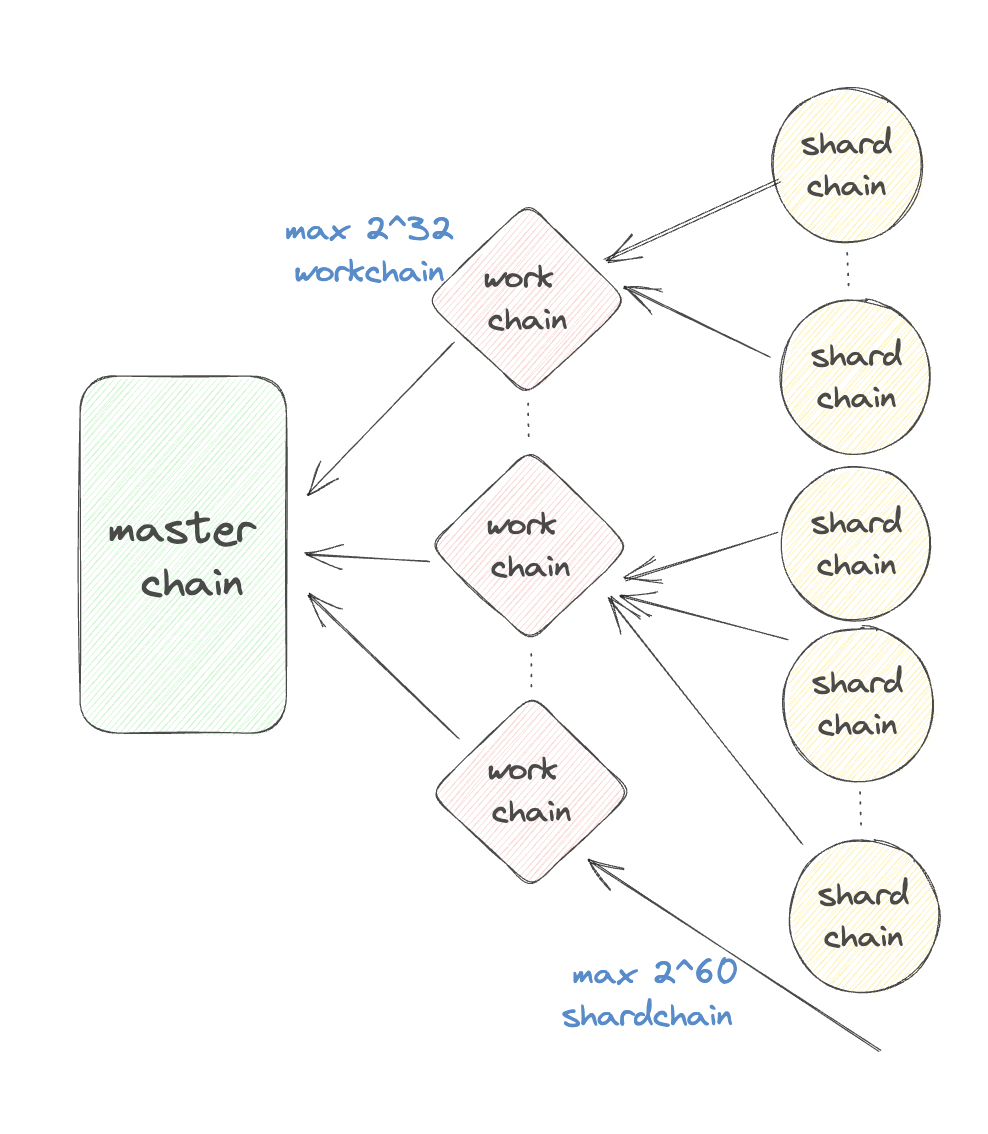
Information delivery mechanism - asynchronous message delivery + message hypercube routing mechanism
Introduction to Message: What each node in TON passes is called message, which is related to its development language (FunCssend_raw_messagefunction). The basic logic is that actors process incoming messages, change their internal state, and finally generate outbound messages;
Introduction to Hypercube Routing: Without considering the total number of shard chains in the system, messages created in one shard chain block can be quickly delivered and processed to the next block of the target shard chain.
Asynchronous message delivery
In an asynchronous system like TON, each transaction is executed only on a single smart contract, communicated through messages. This is different from synchronized blockchains, such as Ethereum. In Ethereum, one transaction may affect and change the status of multiple contracts.
To implement such a system, TON introduces the concept of logical time, or Lamport time, for handling the sequence of events. Each message has its own logical time, which can be used to determine which event occurred first, allowing validators to decide which transactions to prioritize. The operation logic ensures that the logical time of the messages is strictly executed in sequence, and when there are multiple messages, the message with a lower logical time will be processed earlier.
Message hypercube routing mechanism
Traditional hypercube routing includes message passing between three types of chains: between shard chains of the same work chain, between shard chains of different work chains, and between the main chain and other work chains. Each chain is only"connect"to a tile that is a hexadecimal number different from its tile identifier, forming a hypercube graphic. The entire shard chain network forms a hypercube network. The required number of routes is log 16(N), which can support millions of shard chains with 4 nodes.

https://youtu.be/V4 TXwxDS 0 Ss? si=_OvNMQJDntVHTB 6 Q
TON adopts two message routing methods: slow routing and fast routing. In fast routing, Merkle proofs can be used to relay messages directly without submitting them to the intermediate shard chain, thus avoiding additional delays. But the validator will not be penalized if the receipt is lost, so the two run in parallel.
Features include: nodes only need to know the information of neighboring nodes and do not need to know the errors of other nodes; it is based on certain rules rather than purely"asynchronous"Collect input messages; and explicitly delete output queue messages that have been delivered by adjacent shard chains through special transactions, preventing double delivery.
Global state of shard chain - bag of cells and vertical block repair:
"bag of cells"is a group of cells that form a directed acyclic graph (DAG). The process of updating it is to represent the new state as another bag of cells with its own root, remove all cells from the old version, and then combine the old and new sets of cells and delete the old root.
In the TON main chain, each block in the shard chain is actually a small blockchain, also known as a vertical blockchain. If an incorrect shard chain block needs to be fixed, a new block will be submitted in the vertical blockchain. This new block can be used to replace the invalid horizontal blockchain block, or describe the area that needs to be changed. Differences from previous versions of the block. When the vertical blockchain grows faster than the original blockchain, it can be replaced with a new version.

Consensus mechanism - combination of PoS and BFT
POS - 3 roles exist in the network:
1. Verification node: participate in maintaining network security by pledging TON tokens;
Conditions: 300,000 TON needs to be pledged and hardware requirements must be met;
Mechanism: All blocks are created by 100 ~ 1000 selected nodes. The nodes are elected once a month, and the submitted TON Coin is sealed during the election. During their tenure, selected nodes are divided into working groups that create new blocks on the designated blockchain. Each new block will be deemed successfully created if it obtains the signature of a node that holds more than 2/3 of the working groups shares. If it does evil, it will lose funds and be deprived of qualifications;
2. Fisherman (profit by pointing out other peoples mistakes): Check whether the verification node has completed the verification task by sending an invalid certificate. If the verification node passes the invalid certificate, the verification node will be punished;
3. Proofreader (recommends a node to become a validator by nominating it to the validator, and makes a profit if elected): It recommends new shard chain candidate blocks to the validator, proofreads the status of the shard chain and other (usually is the adjacent) shard chain to obtain the data, and the appropriate Merkle proof is sent to the verification node.
BFT: Although DPOS is faster in comparison, the trust level is slower than the BFT system, so TON chooses BFT.
Comparison with other public chains

TONs own characteristics are fast block finality time, fast transaction time, a large number of maximum shards, and shard communication speeds higher than Ethereum: In Ethereum, all users interact with a smart contract, and transactions are executed in order; while TON can Each user wallet creates a chain. Parallel computing of shards, support for instant cross-shard communication and TVM support for asynchronous computing form the theoretical basis for its high TPS;
The core difference between TON, Solana, and Ethereum is the difference brought about by resource payment and asynchrony. The advantage is higher scalability and flexibility, and the disadvantage is the increased complexity of application development and maintenance.
1. Resource payment: In the TON blockchain, each smart contract needs to pay its own resource cost. That is, each smart contract needs to hold a certain number of TON tokens and use these tokens to pay for the resources required for its operation, such as computing, storage and network transmission.
This design prevents users from directly bearing costs, but it also means that the smart contract needs to hold enough TON tokens to cover its running costs. If a smart contracts TON token balance is exhausted, the contract will eventually be deleted. This is an automatic cleanup mechanism that avoids data bloat on the blockchain
2. Asynchronous: In the TON blockchain, calls between smart contracts are asynchronous, not atomic. This means that when one smart contract calls another smart contract, the call is not executed immediately, but is processed on some future block after the transaction ends.
4.TON native components
TON P2P network
Introduction: It is a P2P network transmission protocol similar to IPFS, which can access the TON blockchain, send transactions, and receive client account or smart contract information;
Network structure: TON uses Kademlia Distributed Hash Table (DHT) to locate other nodes in the network, and uses Abstract Datagram Network Layer (ADNL) to communicate between nodes. TON also creates a specific Overlay sub-network for each Shardchain to ensure effective communication. .
1. DHT: Locate other nodes in the network. When the client needs to submit a transaction to the Validator of a Shardchain, it can search in the DHT through the Key to obtain the location of the Validator;
2. ADNL: ADNL abstracts the network layer in the traditional TCP/IP layered architecture. In order to facilitate identification, nodes do not need to consider IP addresses, but use Abstract Network Addresses to communicate. The address is a 256-bit integer based on the hash value of the ECC public key and other parameters, providing the basis for partitioning between different Shardchains;
3. Overlay: Different Shardchains do not need or have the ability to process transactions on other Shardchains, so an Overlay subnetwork needs to be built for each Shardchain within the TON Network. The Overlay network communicates through the ADNL-based gossip protocol.
TON DNS
Introduction: A distributed and scalable naming system based on TON, similar to ENS. TNS can resolve a human-readable name (such as alice.ton) into an identifier that the computer can recognize. It is currently available for sale/auction at https://fragment.com/ (the most expensive TNS sold is .news, which sells for 994,000 TON, about 2 million US dollars);
Published: July 2022;
Availability: Fully available. Users can purchase them as nicknames and wallet addresses, and developers can use .ton domain names to replace smart contract addresses during development;
Ecological support: currently Tonkeeper,TON Web WalletandTonscanThe service has integrated support for TON DNS, which can be found atGeTelegramemsorDisintarWait for the NFT market to be sold. Users who own a domain name need to pay 0.015 TON per year to continue renting the domain name.
TON storage
Introduction: P2P file sharing and storage solution using BT (file seed) technology, similar to dropbox. It can be used to store block copies and status snapshots of the TON blockchain, which is officially called decentralized Amazon S 3;
Published: January 2023;
Availability: Users candemo interfaceIt stores files under 50 MB, but you need to create your own Bag (a collection of files distributed through TON Storage) and obtain Bagid to deploy smart contracts, which is more complicated to use. Developers can store and distribute files of any size on TON or host static TON sites in TON storage by deploying contracts;
Development: In the future, TON Storage customers can use the storage node registry to find storage nodes that meet their needs. The user experience will be further optimized and a TON Torrents application and TON Storage API similar to Dropbox will be launched.
TON Proxy
Introduction: Proxy is a special network service that allows one terminal to indirectly connect to another terminal through this service, thereby providing anonymous access to the network. TON Proxy is the TON network proxy layer, used to hide the IP address of TON nodes. Users can directlyStart the portal agent, this part will be provided to all users in the form of a simple DAPP in the future;
Published: October 2022;
Availability: Users can run .ton websites hosted on TON Storage that do not rely on fixed IPs, and can access these sites using a public entry node compatible with HTTP proxies;
Development: In the future, major TON services can integrate TON Proxy, which has functions similar to the anonymous I2P network, which will ensure the security of IP addresses. Users can also run intermediate proxy nodes and earn profits.
TON payments
Introduction: A micropayment platform integrating micropayment channels, similar to the Lightning Network. Can be used for off-chain transactions and payment of service fees for TON Services;
Availability: Telegram currently integrates the Wallet Bot service, which allows users to conduct virtual currency payment transactions with retail businesses. Search @wallet directly in the Telegram interface to make payments, purchase cryptocurrency, P2P transactions, etc., only channels Network fees apply for creation and closure. Next, the merchant market will be introduced to launch products and services on the @wallet interface;
Development: In the future, a multi-node network will be built. Users can make small payments through intermediate nodes without creating new channels. The intermediate nodes can collect commissions.
TON space
Introduction: Self-hosted wallet in Telegram. @Wallet wallet is KYC and can only call for payment. In TON space, users keep their own private keys and can be called by all smart contracts;
Published: September 2023;
Availability: It is currently in beta status and can be activated in the wallet in your personal account. It only has basic payment and payment functions. In the future, TON Space will serve as a blockchain account and fully support the TON ecosystem including Toncoin, Jettons and Collectibles
Telegram Apps Center
Introduction: Provides a directory showcasing the Telegram Bots and Web Applications (TWA) ecosystem;
Published: August 2023;
Availability: There are currently three types of projects, namely robots, games, and web applications. Users can use the official website, Telegram bot andTelegram Channel about Trending AppsVisit TWA. Developers can alsoReview robots in dedicated applicationsSeamlessly submit new programs developed with the help of
5.Telegram ecology and Ton ecology
Telegram ecological status: Bots+API+wallet hosting
Unibots skyrocketing growth and revenue capabilities have ignited the low-risk, high-yield Bot track: Telegram Bot is simple to create/develop, is bound to telegram, and is easy to use. Its income comes from transaction volume and taxes, and it has strong profitability in the bear market. (The highest monthly income of projects such as $unibot $MEVFree in the first tier is more than 5 million US dollars, and the monthly income of Bot projects in the second tier with a market value of less than 10 million US dollars is hundreds of thousands of US dollars), prompting more teams to turn to Bot;
At present, the Telegram ecosystem is mainly in the form of Bots + API + wallet hosting: It is currently difficult for the Ton Bot ecosystem to directly copy WeChat mini programs. It is easier to apply for the WeChat platform, but TONs small project build in requires a complicated application process, which leads to the thought of It is difficult to embed an official wallet with a better experience. At the same time, development difficulty and cost are high + it is difficult to obtain grant support, which is the deployment status of small projects. Therefore, the small game will choose a compromise rapid deployment method of the game body is in Ethereum layer 2 + telegrams API + off-chain calculation.
Why does Telegram need the TON ecosystem?
Although Bot has good data, there is no actual support for the TON public chain: the Bot ecosystem does not use TON ecological components and does not map tokens;
TON is one of the best ways for Telegram to commercialize: Due to historical sensitivity + Telegram’s single profit method, Telegram must choose a more suitable way to commercialize. The founder of Telegram had a plan for the blockchain in the early days of its establishment. Now Draining traffic through Bot makes it possible for TON to become a unique application base public chain. Therefore, TON is one of the best ways to use telegram;
Why do developers need to switch to the TON ecosystem?
The starting points for the ecological development of the TON Foundation include: Apps Center backflow, TON native payment, telegram community promotion, foundation Grant and investment, lifting API restrictions, etc.;
1. TON native payment: The current @Wallet wallet is KYC and can only call payments. It has a single function and poor scalability. If a product wants to expand its application scale and functionality, it must have a native payment component based on the public chain. TON space is a self-hosted wallet for web3 users. It can call smart contracts and help project parties. It does not require users to import wallets to make payments. The product imagination is greatly improved;
2. Telegram community promotion:
Platform: YesOfficial website、cell phoneterminal promotion botand promotionTelegram channel;
GitHub: Developers who complete bounty tasks will be listed in TON’s GitHub asHall of FameCurrently, there are 106 projects, covering code expansion, NFT and development tutorials;
Advertising: Telegram’s sponsorship information can be displayed on large public 1-to-many channels, so that every user who watches a specific channel on Telegram will see the same sponsorship information. There is no specific user analysis, and it is a wide-net delivery method. The TON Foundation has the right to place advertisements for some projects. For example, the current gamble project @Whale places homepage banner ads on the TON APP official website. In addition, category ads and search ads can be placed;
3. Foundation Grant and Investment: The maximum grant amount is US$50,000, with no specific standards; the investment fund has a profit requirement, and the maximum amount is US$100,000.
Grant: In October 2023, the TON grant program approved 10 projects, including AI intelligent model Tali AI, Ledger Stax integrated application Ledger APP for TON, license-free Launchpad TonUP, decentralized trading tool Optus DEX Aggregator, P2E game Gatto, TON market research tool QSTN, multi-signature wallet Tonkey, application market ton.app, comprehensive communication protocol TON Connect 2.0, and tracking platform TON Tracker;
Foundation: Currently, the foundation has issued $1,200,000 in grants and funded 100+ projects, with an average of $10,000 per project. The 23-year foundation grant projects include the integration of TON wallet and KaiOS, and the lending protocolEVAA Protocol, application platform, development components, prediction market, launch platform, integration with AI, etc.
4. Lift API restrictions: Telegram limits how many messages the bot can send per second (botSend FileThe maximum capacity is 2000 MB, and the file size of the Bot API server that converts requests to HTTP is limited to 20-50 MB), while TON can use unrestricted anonymous RPC to access the API, support data indexing and retrieval, etc., and has great development flexibility Increase;
5. Stable platform: It is difficult for Bots to solve payments and deposits and withdrawals for users, but TON ecological applications can seamlessly connect to the corresponding infrastructure; Bots will charge additional fees on DeFi, while TON DeFi applications only have one layer of lower fees. .
6. Better user experience: Bots have limited response speed, single interaction method and poor multi-interaction parallelism; but TON App can better solve this problem. The current interaction form of Telegram Bots is more like a monotonous proxy page, while the project on TON is an APP with more interactive functions and composability, and projects on the APP Center can be connected by @Wallet. Therefore, the depth of the TON and Telegram Bots projects is very different.
TON ecological projects are rich
Currently, TON’s official ecosystem has included 551 applications: including staking, wallets, browsers, cross-chain bridges, public facilities, NFT, social networking, games, decentralized exchanges and other projects.
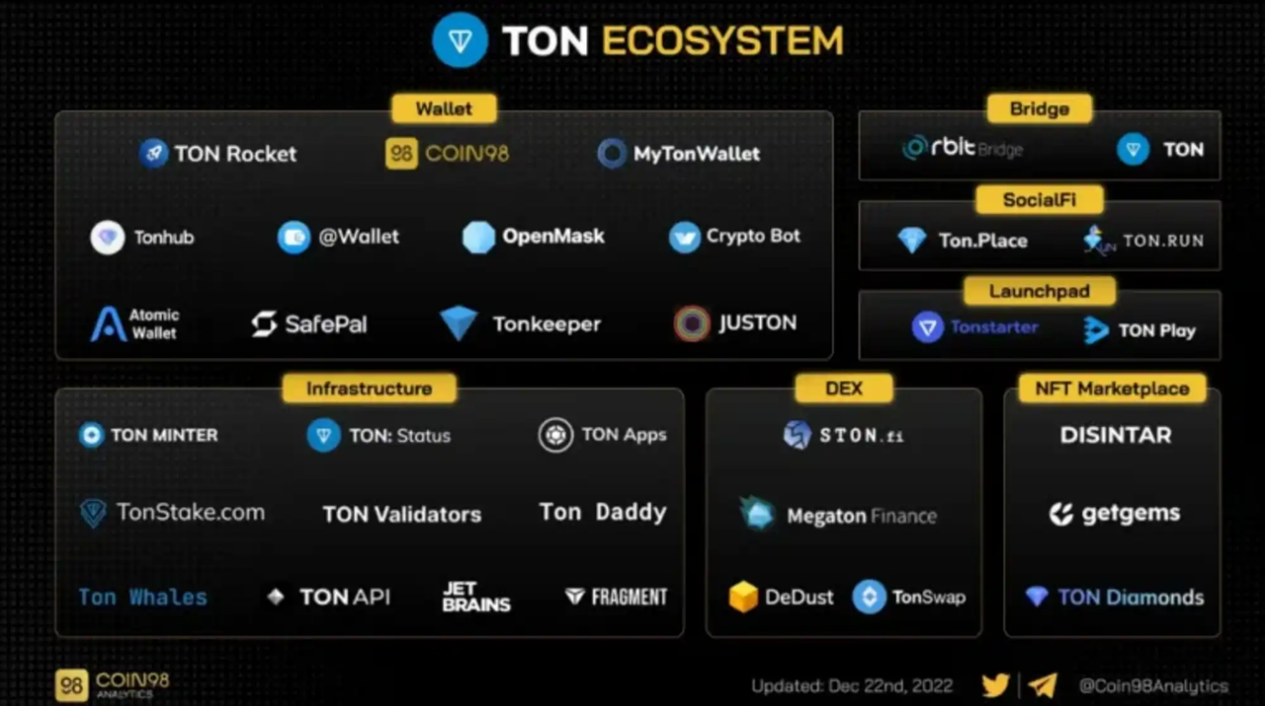
https://twitter.com/ton_ecosystem
1. Wallets: Most of them are built-in components. Only 3 wallets among the top 10 wallets have their own official websites. Their overall functions are basic and their feature is the ecological convenience bound to Telegram. However, considering the security of Telegram and the excessive number of spam messages, I am not sure about users’ willingness to trade.
2. DEX: There are currently 6 DEXs on native platforms, all of which only provide basic swap and liquidity pool functions. The average TVL is 200-500 m, and the data is acceptable; non-native DEX platforms include DODO, uniswap, pancake swap and nomiswap. Overall, it seems that the functions of this sector are rudimentary and development is slow. Most products only support a small number of currencies. The only DEX aggregator OPTUS is temporarily unable to aggregate.
The first problem is that there are no stablecoins:Information aboutIt indicates that Telegram will issue stablecoins in Dubai in October. It may be its own stablecoin, or it may issue USDT first;
Telegram may be listed on the Middle East Exchange (Abu Dhabi/Dubai) National Exchange within two years: The Middle East needs a star project, and Telegram, which has been excluded by Nasdaq and Hong Kong stocks, will be the first.
3. Lending platform: There are currently only two actual pledge platforms (TonStake and Whales pool) available. Other products, such as liquidity pledge hipo finance, are in the test network stage. The overall user interface is rudimentary and only has basic functions, similar to the initial stage of the BTC ecosystem. ;
4. CEX: There are currently 44 CEXs on TON, such as OKX, Huobi, bit, coinEX, gate, biTelegramet, moonpay, etc. The rest are some small/localized exchanges, such as Spain’s bit 2 me and Iran’s اوکی اکسچنج;
5. Cross-chain bridge: The official bridge currently only supports asset interoperability between BSC, ETH and TON, and the transfer of assets in and out is only limited to TON. The third-party bridge Orbit Bridge announced its support for the TON network on December 1, 2022.
In addition to the native asset TON, Orbit Bridge supports cross-chains between TON blockchains such as Ethereum, BNB, Klayth, Polygon and other chains covering USDC, USDT, MATIC and other assets.
6. Utilities: Mainly Bot, providing auxiliary functions similar to widgets, such as faucets, notification robots, transaction tracking, community management tools, and prize-winning quizzes;
7. NFT: There are about 50 series in total. The more well-known series include Annihilation (floor price 198 TON, volume 177.2 K TON), CALLIGRAFUTURISM (floor price 650 TON, volume 21.6 K TON), OCTOPUS BOYZ (floor price 87 TON, volume 75.8 K TON) and METAMORPHOSES (floor price 99.5 TON, volume 38.9 K TON), no famous artists have settled in, the volume is average;
8. Game: 30+ in total. The two popular gamble projects are integrated platforms and embedded in telegram in the form of bots. Other game projects look a bit unsophisticated. They are basically launched directly through small programs and have no official website;
9. DEV component: There are currently 7 components, including the TON development plug-in of IntelliJ Platform (an open source platform for developer tools), Tonana cross-chain bridge, converting contracts into QR codes, Tons contract verification, etc., in addition There are no other useful components, and the official website may even fail to be opened. The overall developer component ecosystem is average.
6.Investment Outlook
Optimistic about officially supported infrastructure
TON Network: Telegrams MTProto protocol can be easily embedded into the RLDP protocol, thereby converting Telegram into a ton-service, which will help Telegrams transformation, and other messaging and social network services of the same type may also benefit from it;
TON original components/middleware: Currently, there are basic network components (P2P and proxy), social networking (DNS, storage), and payment (wallet and TON space). In the future, we can combine and expand around infrastructure, such as one-stop network deployment infra, dynamic site search engine, market data dashboard; defi category will also have opportunities for DEX and aggregator; considering that there are many game projects on TON, based on ERC 721’s NFT market also has certain potential.

Be optimistic about mini program applications
Idea - TON and Ethereums ecology, focus and developer ecology are different: Ethereum focuses on defi, and crypto narrative is strong; TON values the diversity and breadth of small programs, and the narrative is biased towards web 2.5, with experientiality greater than crypto orthodoxy. Just to achieve mass adoption, the language is also more friendly to old web2 developers (who prefer C language).
TON has more opportunities on the application side. The government focuses on supporting small programs. It is difficult to get through the pure crypto application layer. The priority is to first small programs and then defi. The technical innovation of crypto is not the first priority, stability and security are the key points. At present, Telegrams user habits cannot be compared with WeChat. The ecological structure, user stickiness, and user psychological expectations are more like QQ, with many functional functions.
Ton space and telegtam entrances can attract a large amount of web2 traffic. The overall ecology has traffic sources, application scenarios, social relationships, payment gateways and user reach needs. The early components can refer to the development form of WeChat mini programs, targeting a certain type of vertical field:
1. Traffic sources: DApp task distribution platform; Telegram Ads are currently distributed on a wide net, and the business will be more popular if it is targeted; the entry of other Web 3 projects (such as Readon);
2. Application scenarios: App Bot and Web App; Web 2 transplanted content (for example, TON is communicating and cooperating with NetEase’s official team’s card game card ahoy; e-commerce types are converted to Web 3, such as virtual e-commerce, real-world e-commerce, and even crypto e-commerce, etc.;
3. Social relations: TNS-based social graph protocol; social/trading market combined with games; sharing and invitation platform;
4. Payment gateway: combination of credit card and cryptocurrency; combination with RWA; stable mining platform similar to Yue Bao;
5. User reach: Telegram channel; in the future, more Web 2 to Web 3 users can be reached through the combination of TON space and @wallet.
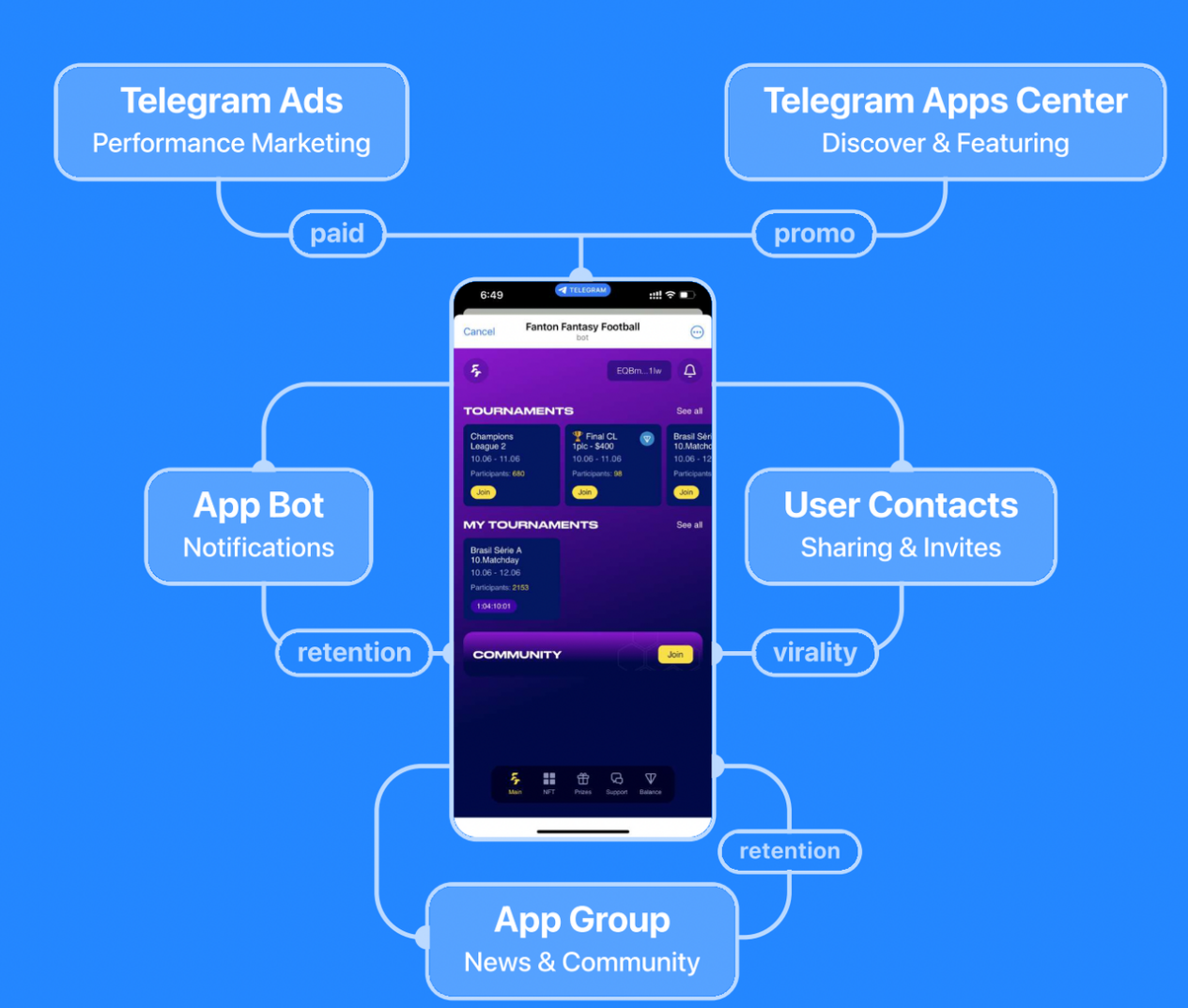
Be cautiously optimistic about DeFi, MEV and ZK
1. DeFi: This type of application does not need to have a very strong degree of crypto innovation. It only needs to meet the basic staking, swap and transaction functions. It has high requirements for security and stability of use. It may be a large application with traditional crypto accumulation. Exchange/product opportunities;
2. MEV problem: There are currently no large transactions, and it is not yet time to solve such problems. The current priority is to create more assets and increase transaction demand;
3. ZK and bridge: Both are very important, but it is still early to deploy and need to wait for the infrastructure to continue to be built. And the key to TONs growth is not the bridge, because the bridge is the allocation of stock to attract liquidity from the Ethereum ecosystem, and TON wants to develop new traffic, and the legal currency stable currency is a more important focus; in the short term, it is not optimistic about the direction of Layer 2 and zk;
Outlook for other tracks
1. Dev Tools/Community: The characteristic of Dev on TON is that it is difficult to deploy and develop, but the theoretical TPS is higher. There are few official technical resources, which is difficult for small teams to develop. Therefore, the first direction is to lay out the developer ecosystem and optimize the developer experience. Such directions include business directions such as TWA connected to RPC, or development tool kits, codeless deployment platforms, etc. However, considering that TON has Archive node requirements, such projects require higher technical accumulation and background requirements for the team;
2. Social Payment and parallel payment infrastructure: such as Onlyfans in the creator economy, which needs to solve the problem of interaction between creators and users; there are also directions for social media operators such as private domain traffic monetization;
3. Binding of games and social graphs: such as social media traffic distribution platforms, mini-game platforms and social graphs, and NFT markets. Or the transplantation of traditional games, such as casual games like Tiantian Kuaipao, Landlords, and social games like Happy Farm, which can naturally be combined with the token economic model;
4. New value creation and circulation: connection with traditional social media.
at last
Since its founding in 2018, TON has experienced a series of challenges and transformations, including ICO, restart, and ecosystem reconstruction. With the active promotion of the foundation, its market value has achieved significant growth and its user base has also expanded. It has flexible unlimited sharding technology and efficient consensus mechanism, making it a scalable and highly secure blockchain network.
Regarding the future of TON, it is expected that with the support of Telegram, it is expected to expand its market share and achieve greater user coverage. The superiority of TON and the integration of Telegram payment give it a lot of room for development in the social media ecosystem. However, due to the complexity of TONs development language and asynchronous design, it is also very challenging for developers, which may limit the rapid development of the ecosystem.
The TON ecosystem has included 551 applications, and this number is still growing rapidly, indicating that TON is gradually building a diverse and rich ecosystem. In the future, by optimizing infrastructure, providing one-stop deployment services, and improving the experience of various functions, the TON ecosystem may introduce more developers to participate.
Overall, TON has a good development trend. It integrates Telegrams user base and a good technical framework, which means it has huge development potential. TONs infrastructure, mini-program applications and other directions are worthy of attention, but both investors and developers need to make prudent decisions to participate based on a deep understanding of the TON ecosystem and related technologies.
References
• Official website: https://ton.org/
•Official Twitter: https://twitter.com/ton_blockchainhttps://twitter.com/ton_ecosystem
•In cooperation with the TON Foundation and Tencent Cloud, is Telegram going to start building an “international WeChat”? https://www.theblockbeats.info/news/45815
•Social and crypto, Telegram’s next decade https://www.theblockbeats.info/news/44789?search=1
•Detailed explanation of The Open Network. Is TON, which no one cares about, on the eve of skyrocketing? https://www.theblockbeats.info/news/44943
•Discuss whether Ton can make Telegram become the WeChat of Web3 from Telegram Bot https://www.theblockbeats.info/news/44753
•How is the TON public chain performing in the bear market? https://www.theblockbeats.info/news/33102
•How does Telegram provide users with encryption services through TON? https://www.techflowpost.com/article/detail_11086.html
•The Open Network: Backed by Telegram, explore the interconnection between Web2 and Web3 https://www.techflowpost.com/article/detail_14015.html
•TON Rebirth: Brief History of Creation, Technology Advancement and Future Prospects https://www.panewslab.com/zh/articledetails/17j4cqu8b3cl.html
•Based on Telegram’s TON, explore the interconnection between Web2 and Web3 https://www.panewslab.com/zh/articledetails/yyhfsbpf.html
•The TON network was sued by the SEC, and Gram may not be able to trade in the United States in the short term https://www.theblockbeats.info/news/3878
•TON Community Edition testnet is online, airdropping TON mainnet tokens to all Telegram users https://www.theblockbeats.info/news/18537
•Understanding Unibot in one article https://www.gate.io/zh/learn/articles/understanding-unibot-in-one-article/759
•The most undervalued public chain? TON ecological inventory built on Telegram https://www.panewslab.com/zh/articledetails/xaf6an5q.html
•TON ecological information: https://jimsyoung.notion.site/TON-800ea614ae6a4e9ca9560864e591c82a
•TON Foundation Demo Day #2: TonX joins existing accelerator partners https://blog.ton.org/ton-foundation-demo-day-2-tonx-joins-existing-accelerator-partners
•Technical interpretation of the third-generation blockchain operating system TON https://www.infoq.cn/article/hefzg0pgdeawvooqt268
•From a technical perspective, study how the public chain TON, backed by Telegram, emerged? https://mp.weixin.qq.com/s/0KgTlhtcU5DGqBw27yJZ_w
•TACT tutorial: https://github.com/tact-lang/awesome-tact
•Interpretation of the history of The Open Network: from failure to phoenix nirvana https://share.foresightnews.pro/article/detail/45007



